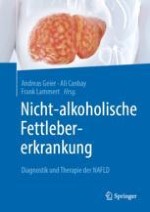Zusammenfassung
Die nicht-alkoholische Fettlebererkrankung (NAFLD) spielt als hepatische Manifestation des metabolischen Syndroms, dessen Prävalenz steigt, eine zunehmend wichtige Rolle als Komorbidität in der Diagnostik und Therapie der chronischen Lebererkrankungen. Während bei der chronischen Hepatitis B im Gegensatz zur Hepatitis-C-Infektion keine spezifische Assoziation zu einer hepatischen Steatose vorzuliegen scheint, ist diese dennoch mit einer geringeren Wirksamkeit der antiviralen Therapie in Bezug auf die Fibroseregression verknüpft. Analog zeigt sich bei den autoimmunen und cholestatischen Hepatopathien ein erhöhtes Risiko einer Fibroseprogression, wenn zusätzlich eine nicht-alkoholische Fettlebererkrankung (NAFLD) vorliegt. Bei der Hämochromatose hingegen zeigt sich die Datenlage hinsichtlich eines signifikanten Zusammenhanges einer NAFLD und einer Fibrose weniger einheitlich. In diesem Kapitel soll der Zusammenhang zwischen NAFLD bzw. dem metabolischen Syndrom und anderen chronischen Lebererkrankungen näher beleuchtet werden.











